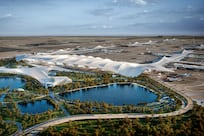If I pick my way around a collection of nondescript modern houses called Midfield Drive, I can locate the spot where, year after year, I spent Saturday afternoons or weekday evenings cheering a Sunderland AFC victory or, as likely, reduced to misery by defeat. I am not, of course, talking about the Stadium of Light, the bright, state-of-the-art stadium the club now call home, vastly superior as it may be to any other bright, state-of-the-art stadium I have seen. Roker Park, where Sunderland played for one year short of a century, was the centre of my universe.
My part of the ground was slightly to the left of the halfway line in a standing enclosure known as the Clock Stand paddock. You had a good view of the entire pitch provided you were tall enough, though you were assured of a buffeting if there was a big crowd. I also got very wet, very cold and very dispirited there on many occasions. But when things were good, the weather mattered little: an FA Cup replay against Man Utd in 1964 when gates were forced open by the weight of the crowds seeking entry; the ecstasy of promotion clinched in the last game of the season in 1980, and the overwhelming relief of a win to stave off relegation in 1995. By the end, in 1997, the stadium was a tattered, torn relic of a vanishing age, fit only for demolition. But if you ask me where I grew up, the answer is Roker Park all the same.





